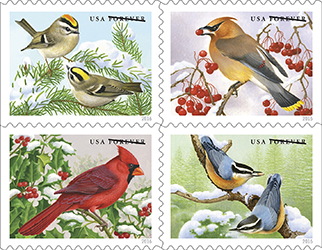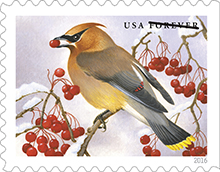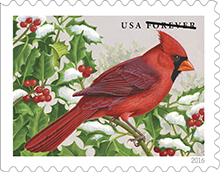
PORTLAND, OR — The U.S. Postal Service celebrated four birds that brighten cold winter days today by dedicating the Songbirds in Snow Forever stamps at the American Philatelic Society’s Stampshow 2016 in Portland, OR. One of the birds, the northern cardinal, is the state bird for Illinois, Indiana, Kentucky, North Carolina, Ohio, Virginia and West Virginia.
The stamps are available in booklets of 20, with each of the four stamp designs repeated five times. They feature the golden-crowned kinglet (Regulus satrapa), the cedar waxwing (Bombycilla cedrorum), the northern cardinal (Cardinalis cardinalis) and the red-breasted nuthatch (Sitta canadensis). Illustrator Robert Giusti painted the original designs in acrylic on canvas board, depicting each bird perched on a snow-covered branch.
“The Postal Service has a long tradition of putting birds on stamps — to celebrate and raise awareness of these amazing creatures,” said U.S. Postal Service Vice President of Sales Cliff Rucker, the dedicating official. “And the four stamps we’re dedicating today,” he added, “are truly beautiful works of art.”
Joining Rucker in dedicating the stamps was American Philatelic Society Executive Director Scott English. U.S. Postal Service Stamp Services Director Mary-Anne Penner served as master of ceremonies.
Visit the Postal Service’s Event Calendar for information on upcoming stamp events.
Ordering First-Day-of-Issue Postmarks
Customers have 60 days to obtain the first-day-of-issue postmark by mail. They may purchase new stamps at their local Post Office, at The Postal Store website at usps.com⁄shop or by calling 800-782-6724. They should affix the stamps to envelopes of their choice, address the envelopes (to themselves or others) and place them in a larger envelope addressed to:
Songbirds in Snow Stamps
U.S. Postal Service
ATTN: Ruth Traynor
PO Box 2089
Portland, OR 97208-2089
After applying the first-day-of-issue postmark, the Postal Service will return the envelopes through the mail. There is no charge for the postmark up to a quantity of 50. There is a 5-cent charge for each additional postmark over 50. All orders must be postmarked by October 4, 2016.
Ordering First-Day Covers
The Postal Service also offers first-day covers for new stamp issues and Postal Service stationery items postmarked with the official first-day-of-issue cancellation. Each item has an individual catalog number and is offered in the quarterly USA Philatelic catalog, online at usps.com⁄shop or by calling 800-782-6724. Customers may request a free catalog by calling 800-782-6724 or writing to:
U.S. Postal Service
Catalog Request
PO Box 219014
Kansas City, MO 64121-9014
Stamp Subject Background
The sight of birds sitting on a snowy tree branch and the sound of their songs and calls bring joy in the depth of winter. Though many birds migrate to warmer climes before the snow falls, some hardy birds have ways to cope with the cold and to find food year-round.
In winter, much of the birds’ day is spent looking for food; they consume large quantities to supply the energy to keep warm at night when temperatures plummet. Fluffing their feathers creates an insulating layer of air. Their winter plumage can contain up to 30 percent more feathers than in summer. Many birds are able to slow their metabolism, lower their body temperatures or even reduce their heart rate to help them conserve energy. Some species gather in groups to search for food and to snuggle together at night to maintain body heat.
Winter birds will search for roosting places that provide protection from precipitation, wind and predators. They generally choose the same kinds of habitats that they use for nesting including cavities in trees, thickets, birdhouses, shrubs or evergreen trees. Even the smallest birds will thrive in the winter cold if they can find food.

Golden-Crowned Kinglet
The golden-crowned kinglet (Regulus satrapa) is only a little larger than a hummingbird. It can survive nighttime temperatures of 40 degrees below zero. The tiny birds roost in evergreen forests and huddle together in small flocks high up in the branches to help them stay warm. Wary of taking food from a birdfeeder, its winter diet is made up mainly of dormant insects and their eggs as well as overwintering caterpillars.

Cedar Waxwing
The cedar waxwing (Bombycilla cedrorum) gets its name from its favorite winter food, cedar berries and the red, waxy tips of some of its wing feathers. One of the few North American birds that thrives on a diet of mostly fruits, the cedar waxwing also consumes the winter fruits of the juniper, mistletoe, crabapple and other plants. It generally inhabits open woodlands and hedgerows, but in winter it will join a flock around fruiting plants, including those in backyards and gardens, to feed.

Northern Cardinal
A spot of bright red against the white of a snowy tree branch signals the presence of a northern cardinal (Cardinalis cardinalis), one of winter’s most colorful and beautiful birds. Found in thickets along the edge of forests or in shrubby, overgrown fields and hedgerows as well as in backyards, cardinals usually appear in pairs but can gather in small flocks during the winter to forage for food. Their diet is mainly seeds and fruit, but they also eat insects. During the winter, cardinals are frequent visitors to birdfeeders. Sunflower seeds are a favorite food.

Red-Breasted Nuthatch
The red-breasted nuthatch (Sitta canadensis), with its distinctive call like a tiny toy horn, prepares well for the season by caching conifer seeds, its preferred winter food. Stashed in cracks and openings in tree bark, the seeds are collected by the bird as it walks headfirst down the trunk. It lives mainly in coniferous forests, but the inquisitive little bird is attracted to birdfeeders, drawn particularly to sunflower seeds, peanuts and suet.
The Postal Service receives no tax dollars for operating expenses and relies on the sale of postage, products and services to fund its operations.
# # #
Please Note: For broadcast quality video and audio, photo stills and other media resources, visit the USPS Newsroom at about.usps.com/news/welcome.htm.
For reporters interested in speaking with a regional Postal Service public relations professional, please go to about.usps.com/news/media-contacts/usps-local-media-contacts.pdf.
Follow us on twitter.com/USPS and like us at facebook.com/USPS. For more information about the Postal Service, go to usps.com and usps.com/postalfacts.

